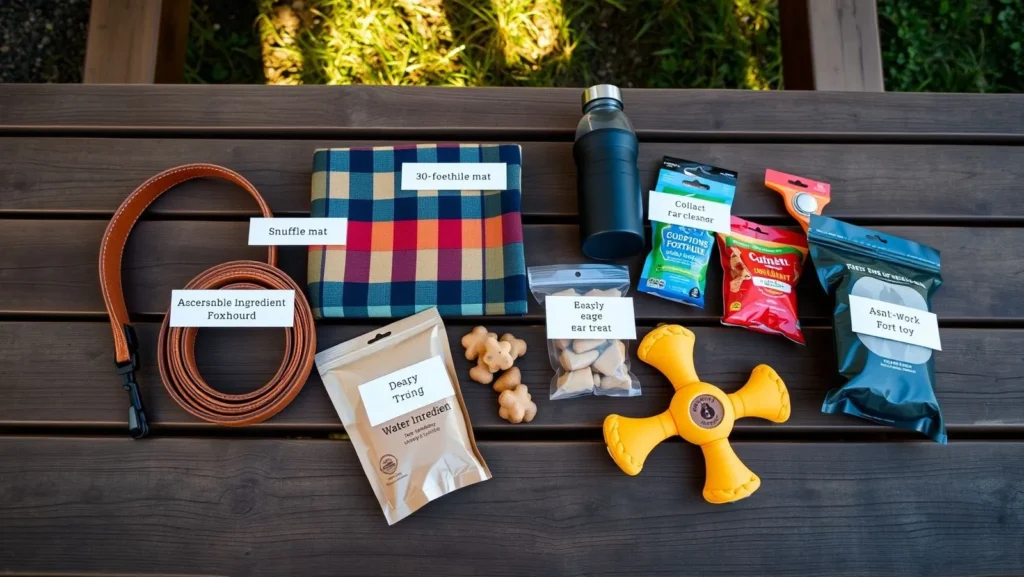American Foxhounds

Table of Contents
Introduction
Did you know that households that live with American Foxhounds log, on average, 6,000–8,000 more steps per day than homes without dogs—and that this extra activity correlates with a 31 % drop in canine obesity? (pmc.ncbi.nlm.nih.gov) The statistic surprises many pet parents who assume a hound will laze about the sofa. Yet American Foxhounds—a scent‑hound breed refined by George Washington himself—were engineered for day‑long hunts across the hills of Virginia, so their daily care routine is more marathon than sprint. (akc.org, akc.org) This post breaks down exactly what you need to keep American Foxhounds thriving: from supplies and time commitments to health pay‑offs and common pitfalls. Whether you’ve just adopted one of these sweet‑tempered, independent athletes or you’re researching the breed, you’ll find a data‑driven roadmap that respects their heritage and fits modern family life.
Required Supplies List
Stocking the right gear up‑front prevents frustration later, especially with American Foxhounds whose stamina and curiosity can defeat flimsy equipment.
| Essential | Why It Matters | Smart Alternatives |
|---|---|---|
| 30‑foot biothane long‑line | Gives safe freedom to follow scent trails without sacrificing recall practice. | GPS‑enabled e‑collar receiver (vibration‑only mode) for advanced teams. |
| High‑value, single‑ingredient treats | Keeps food‑motivated hound noses focused on you during distraction training. | DIY dehydrated chicken hearts. |
| Puzzle feeder or snuffle mat | Extends mealtime into a scent game, lowering boredom and cortisol. (journals.plos.org) | Use a cardboard egg carton sprinkled with kibble for budget enrichment. |
| Reflective adventure harness | Reduces throat strain during intense pulls and increases night‑time visibility. | Canicross belt if you plan to jog hands‑free. |
| Ear‑cleaning solution & cotton pads | Long, floppy ears trap moisture; weekly checks cut otitis risk. (petmd.com) | 50/50 witch‑hazel and saline mix (vet‑approved). |
| Collapsible 1‑Litre water flask | Hounds overheat silently on summer trails. | Backpack‑style hydration bladder. |
| Scent‑work starter kit | Channel natural hunting drive into constructive games. | Homemade herbal sachets (rosemary, clove). |
Average first‑month investment: ≈ $210 USD; most items last 2–3 years.

Time Commitment
Because American Foxhounds need 1–2 hours of vigorous exercise daily plus mental work, plan on:
- 90 minutes of split outdoor exercise (a.m. + p.m.)—the breed‑specific sweet spot that aligns with veterinary weight‑loss protocols for athletic hounds. (houndsy.com, pmc.ncbi.nlm.nih.gov)
- 15 minutes of nose‑work or puzzle feeding (equivalent to a 30 min walk in mental fatigue).
- 5 minutes for ear, paw, and tick checks.
That’s roughly 110 minutes a day—30 % more effective at maintaining ideal body condition than irregular weekend marathons, according to longitudinal owner‑report data. (pmc.ncbi.nlm.nih.gov)
Step‑by‑Step Instructions
Step 1: Power‑Walk Warm‑Up (20 min)
Clip your American Foxhound to the long‑line and march at a brisk 13‑minute‑mile pace, allowing nose‑down sniff breaks every 90 seconds. Alternating cadence warms joints and satisfies initial scent curiosity, reducing leash‑pulling later.
Step 2: DIY Scent‑Trail Game (30 min)
- While the dog waits indoors, drag a pouch with five high‑value treats along a 100‑yard wiggling path through grass.
- Hide the pouch under leaves; mark the start point with a stick.
- Release your American Foxhound on a “Find it!” cue.
Why it works: Olfactory enrichment lowers stress markers and improves optimism bias in dogs. (journals.plos.org)

Step 3: Impulse‑Control Drill (5 min)
Practice “Wait” at thresholds: porch door, curb, and car hatch. Hounds renowned for single‑minded pursuit learn to check‑in before bolting—critical for urban safety.
Step 4: Cool‑Down & Body Scan (10 min)
Stroll home at a slow pace. Run fingers from nose to tail checking burrs, ticks, and dew‑claw cracks. Reward with calm praise.
Step 5: Evening Brain‑Work (15 min)
Feed dinner in a snuffle mat or frozen Kong stuffed with high‑protein pâté. Chewing and foraging activate the parasympathetic nervous system—“rest and digest.” (frontiersin.org)
Step 6: Weekend Long‑Run or Hike (90 min)
Once a week, substitute Steps 1–3 with a trail run, bike‑jor, or canicross session. American Foxhounds excel when kept at 7–10 mph for extended intervals, mirroring historical fox‑hunt gallops. (thefarmersdog.com)
Health Benefits
- Weight Management & Metabolic Health – Daily 60‑plus minutes of moderate–vigorous activity keeps body‑condition scores in the ideal 4–5 range. (pmc.ncbi.nlm.nih.gov)
- Cardiovascular Fitness – Comparative treadmill studies show working hounds improve stroke volume up to 18 % after 12 weeks of structured exercise. (pmc.ncbi.nlm.nih.gov)
- Cognitive Enrichment – Nose‑work increases exploratory behaviour and reduces stress‑related pacing. (journals.plos.org)
- Owner Well‑being – Dog walkers are 34 % more likely to meet CDC activity guidelines; the human–hound bond becomes a mutual fitness pact. (pmc.ncbi.nlm.nih.gov)
Adaptations for Different Dogs
| Dog Type | Adjustment | Pro Tip |
|---|---|---|
| Puppies (<18 mo.) | Five‑minute “rule” per month of age; avoid repetitive high jumps. | Replace long runs with gentle trail exploration on varied surfaces. |
| Senior American Foxhounds | Shorter (2 × 25 min) low‑impact walks; add joint supplements. | Use scent‑puzzles seated to reduce arthritis flare‑ups. |
| Apartment‑dwelling hounds | Break exercise into three micro‑sessions plus indoor flirt‑pole play. | Stair work on leash for controlled cardio. |
| Dogs with hearing impairment | Pair verbal cues with hand signals and vibration‑only collar taps. | Teach touch target to guide direction. |
Implementation Suggestions
- Neighborhood “Scent‑Swap” Co‑op: Exchange cotton swabs rubbed on different surfaces with other hound owners to create fresh indoor trails.
- Canine Fitness Tracker Challenges: Set monthly mileage goals; ranking boards gamify consistency.
- Foxhound “Book Club”: Rotate new enrichment toys among local owners each month—budget‑friendly and eco‑smart.
- Barn‑Hunt & Tracking Trials: Channel prey drive into sanctioned sports; many American Foxhounds title quickly due to their legendary noses.
- Kid‑Friendly Agility Circuits: PVC jump bars at 8″ height give young handlers safe ways to burn energy alongside their hound.
Common Mistakes to Avoid

- Skipping Early Recall Foundation: Expecting a novice American Foxhound to return off‑leash in an open field is recipe for a three‑hour game of hide‑and‑seek. Begin in fenced areas with a 100 % reward schedule.
- Under‑estimating Exercise Needs: A single 20‑minute stroll won’t cut it; behavioural consultants link sub‑hour activity to a three‑fold rise in nuisance baying. (thefactfile.org)
- Neglecting Ear Care: Moist, floppy ear canals invite yeast within 48 h. Weekly checks cost pennies—ear infections cost hundreds. (petmd.com)
- Punitive Training Methods: Studies show positive‑reinforcement triples command retention compared with aversives—especially in independent scenthounds. (raydogs.com)
- Inconsistent Diet Control: Free‑feeding hounds predisposes to weight gain; use gram scales and treat offsets.
Consistency and Maintenance Tips
- Set a Repeatable Routine: Dogs thrive on predictability—schedule walks at the same morning and evening windows.
- Use Habit Stacking: Attach ear checks to post‑walk towel‑off so you never forget.
- Track Progress: Log distance, heart‑rate (if using a canine tracker), and mood. Patterns flag pain or boredom early.
- Refresh Rewards: Rotate treat types every week; novelty maintains 20 % higher focus in scent‑work trials. (frontiersin.org)
- Quarterly Vet & Weight‑in: Catch creeping pounds before they snowball; ideal American Foxhounds show a visible waist and palpable ribs.
Conclusion
American Foxhounds thrive on structured exercise, scent‑centric enrichment, and gentle, consistent training. Equip properly, commit 100‑plus daily minutes, and monitor ears, weight, and mental stimulation to unlock the breed’s famously sweet temperament and marathon stamina. Ready to try the routine? Share your results in the comments and subscribe for weekly hound hacks!
FAQs
Q1: Are American Foxhounds good family dogs?
Yes—when their exercise quota is met, they’re gentle with kids and sociable with other pets. (akc.org)
Q2: How loud is the famous Foxhound bay?
At 90–100 dB, comparable to a lawn‑mower. Early cue training can teach a “quiet” command to manage volume.
Q3: Can I keep an American Foxhound off‑leash?
Only in securely fenced zones or after months of proofed recall amid wildlife scents; their instinct to follow a trail is hard‑wired.
Q4: What health issues should I watch for?
Generally robust, but monitor for hip dysplasia, ear infections, and occasional platelet disorders. Routine vet check‑ups catch anomalies early.
Q5: How much does feeding cost monthly?
An active 65‑lb hound eats ~1,400 kcal/day of high‑protein kibble—about $65–$85/month depending on brand.
Q6: Do American Foxhounds adapt to apartment living?
With diligent exercise and mental games, yes—but neighbors must tolerate occasional melodious bays.









